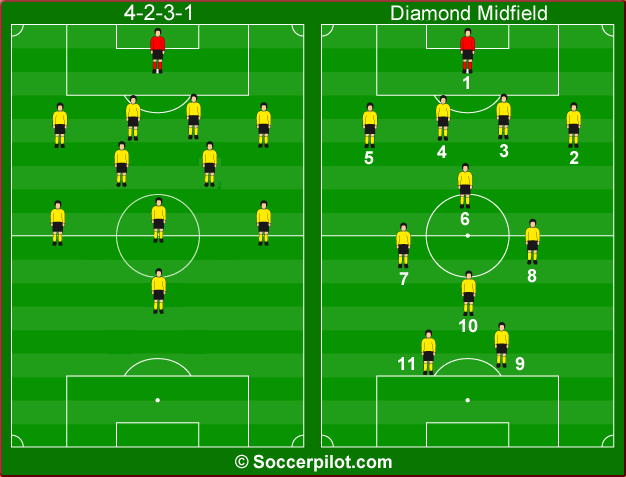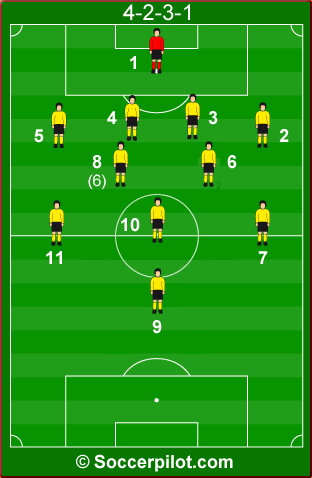Short introduction to the 4-2-3-1 formation and system of play (soccer's double six)
To become familiar with the formations and systems of play, you should first read our "The Foundations of the 4-4-2 (Diamond Midfield)" and "The Foundations of the 4-4-2 (Flat Four)“ articles. We have structured the systems of play in a systematic way and so that they are easy to understand.
The 4-2-3-1 is probably one of the most widely used formations in professional soccer. This system is, for example, played by Borussia Dortmund, one of the 2013 Champions League finalists.
As opposed to the 4-4-2 with the "Flat Four", the "second" back four is completely resolved with the 4-2-3-1 formation. With the usage of four player rows, the development of complex soccer formations and systems of play was also incorporated into this designation. The logical division into defense, midfield and offense was lost in the process. With the 4-4-2, this differentiation is still far more apparent to the layman. The 4-2-3-1 is thus a 4-5-1 and this points to a strongly positioned midfield. The "trisection" of the system may sound easier, but often leads to misunderstandings. The 4-2-3-1 explains the tactical concept far more clearly. Furthermore, there are additional 4-5-1 systems, like for example the 4-1-4-1.
By comparing the 4-2-3-1 with the diamond formation of the 4-4-2, we may recognize the structures of the 4-2-3-1 more clearly.
This can be seen in the following illustration: In the basic formation, we move number 8 back from the diamond to the position next to number 6. A system of play with two "sixes" results from the diamond formation with merely one "six" and we are thus playing 4-2-3-1 with a "double six" or “double pivot” and therefore two holding midfielders, henceforth referred to as the “sixes”, capable of flexibly reacting to the progression of the game. In the actual midfield, three players are playing in a single row as part of the 4-2-3-1. As opposed to the diamond, only one player remains in the front of the 4-2-3-1. In most cases, this is also a classic center forward.

The 4-2-3-1 looks like a very defensive formation in the graphic illustration, but this is dependent on the distances between the individual rows. When in possession of the ball, it is possible to rapidly "switch" and create "superior number" situations which may even be reinforced by the role of the "sixes". If one of them joins the attacking play, the pressure on the opposing defense is even more increased.
Without going into any more details, you will surely recognize the flexibility of the 4-2-3-1. If the left and right midfielders move forward from the midfield, they become wingers. If one of the "sixes" and/or the defenders joins the attacking play, a strong offensive play quickly develops (a 4-4-3 in this example). One thing is for certain with this system: a strong midfield. We will now describe the individual rows of the 4-2-3-1 and the roles of the players in detail:

The 1 (Goalie)
The tasks of the goal keeper have been detailedly described as part of other systems of play/formations and a number of articles. Similar to the 4-2-3-1, he is the first attacker and the last defender. Due to the "double six" and the good defensive behavior of the midfielders, the pass ways into the joints of the "four back" are well blocked. In case of inaccurate passes by the attackers or passes above or via the "four back", the goal keeper should secure and command the rear space.
The first 4 (Defenders)
A "four back" is situated in front of the goal keeper (players 2 to 5). Players 2 and 5 are the wing-backs while 4 and 3 are the center-backs.
Today's wing-backs are fast, agile, confident with the ball and often join the attacking play in a quick-witted and clever manner. A very good technical education is important for every position today.
In this system, the wing-backs are often faced with the difficult problem that they cannot be immediately supported by their fellow team mates; running paths are often very long for defensive players. For this reason, the wing-backs have to be strong tacklers that are capable of delaying the opponent's attack.
The 2 - (double six)
It's actually superfluous, but we will go into it anyway. Our "sixes" need to possess a high degree of footballing intelligence and the ability to "read" a game. But all players need that nowadays, don't they?
The "double six" is often interpreted in the following way as part of this system of play: one of the "sixes" is more offensively oriented, is often unmarked in the midfield and thus can be passed to, additionally takes care of the playmaking and secures the rear space behind number 10 if his team is in possession of the ball. The second "six" is mostly responsible for defensive tasks. Ideally, the two players swap their roles in the system of play time and time again, in order to become less predictable.
In the defensive, the "sixes" may easily form triangles with two players of the "four back" on their sides and thus heavily attack the opposing player in possession of the ball. Gaps for possible passing routes are automatically closed in the process and if possession of the ball is won, it is easy to find access to the wing players in the midfield. However, the running paths are often very long as described above and it is often hard to support the wing-backs.
The 3 - (the midfield)
The midfield of the 4-2-3-1 formation is very flexible. Number 10 constitutes a real "playmaker" and the two wing players are nearly equal to real wing attackers or wingers. Constant advances of the players in the offensive (alternating, if possible) cause problems and confusion for the opposing defense.
Due to this offensive, a 4-3-3 often automatically results when in possession of the ball.
Requirements concerning the willingness to run and tactical discipline are very high but mandatory in order to successfully play these frequent system changes.
The 1 (Striker)
One player in the offense sounds like a typical center forward who not only has to be tall and good at heading but also capable of achieving successful tackles. But times are slowly changing for the 4-2-3-1 formation as well and a "false nine", a flexible attacker, can often be found in this position.
This concludes our short introduction to the 4-3-2-1 system. This system is very complex and not fixed in any way. The motivation, skill and footballing intelligence of the team are even more important here as compared to other systems. If the entire team does not consistently work both offensively and defensively, gigantic gaps will develop. Learning this is not only a challenge for the team, but also for the trainer.
Systems of play:
The Foundations of the 4-4-2 (Diamond Midfield)
The Foundations of the 4-4-2 (Flat Four)